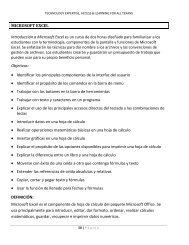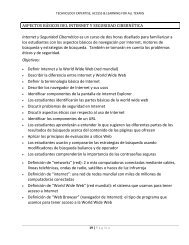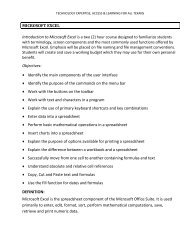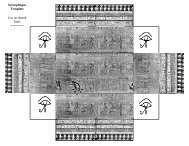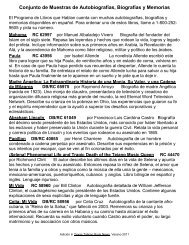Begin with the End in Mind: A Records Management & Archives ...
Begin with the End in Mind: A Records Management & Archives ...
Begin with the End in Mind: A Records Management & Archives ...
Create successful ePaper yourself
Turn your PDF publications into a flip-book with our unique Google optimized e-Paper software.
The <strong>Archives</strong> War<br />
Chapter 1<br />
The Texas State Library and <strong>Archives</strong><br />
Commission<br />
Vision<br />
The people of Texas have access to and effectively use <strong>in</strong>formation,<br />
archival resources, public records and library materials to<br />
improve <strong>the</strong>ir lives, <strong>the</strong> lives of <strong>the</strong>ir families and <strong>the</strong>ir<br />
communities. All people will benefit from expanded opportunities<br />
and resources to explore diverse pathways to knowledge and<br />
wisdom.<br />
Mission<br />
The mission of <strong>the</strong> Texas State Library and <strong>Archives</strong> Commission is<br />
to safeguard significant resources, provide <strong>in</strong>formation services<br />
that <strong>in</strong>spire and support research, education and read<strong>in</strong>g, and<br />
enhance <strong>the</strong> capacity for achievement of current and future<br />
generations. To accomplish this, we<br />
Preserve <strong>the</strong> record of government for public scrut<strong>in</strong>y,<br />
Secure and make accessible historically significant records<br />
and o<strong>the</strong>r valuable resources,<br />
Meet <strong>the</strong> read<strong>in</strong>g needs of Texans <strong>with</strong> disabilities,<br />
Build and susta<strong>in</strong> statewide partnerships to improve<br />
library programs and services, and<br />
Enhance <strong>the</strong> capacity for achievement of <strong>in</strong>dividuals and<br />
<strong>in</strong>stitutions <strong>with</strong> whom we work.<br />
The Texas State Library and <strong>Archives</strong> Commission adm<strong>in</strong>isters<br />
<strong>the</strong> state's library and records programs. There are six divisions<br />
and programs: <strong>Archives</strong> and Information Services, Library<br />
Development and Network<strong>in</strong>g, State and Local <strong>Records</strong><br />
<strong>Management</strong>, Talk<strong>in</strong>g Book Program, Adm<strong>in</strong>istrative Services<br />
and Information Resources Technologies.<br />
The <strong>Archives</strong> and Information Services division oversees<br />
<strong>the</strong> transfer of legislative records to <strong>the</strong> Texas State<br />
<strong>Archives</strong>.<br />
The early Texas republic faced many<br />
decisions, <strong>in</strong>clud<strong>in</strong>g choos<strong>in</strong>g a site<br />
for a permanent capital. The Texas<br />
Congress favored a Central Texas<br />
location; however, President Sam<br />
Houston preferred <strong>the</strong> city of Houston.<br />
In 1839, President Mirabeau B. Lamar<br />
chose a t<strong>in</strong>y settlement, Waterloo,<br />
now called Aust<strong>in</strong>. Forty wagons<br />
carried <strong>the</strong> government archives from<br />
Houston to <strong>the</strong>ir new home. Over <strong>the</strong><br />
next several years, <strong>the</strong> archives would<br />
become a highly visible symbol of a<br />
tug-of-war for government power <strong>in</strong><br />
Texas.<br />
In 1841, Sam Houston aga<strong>in</strong> became<br />
president. The next year, Houston<br />
saw his chance to move <strong>the</strong> capital<br />
back to <strong>the</strong> city of Houston. The<br />
Mexican army <strong>in</strong>vaded Texas and<br />
took control of San Antonio, Goliad<br />
and Victoria. Argu<strong>in</strong>g that Aust<strong>in</strong> was<br />
defenseless aga<strong>in</strong>st Mexican attack,<br />
Houston ordered <strong>the</strong> archives back to<br />
Houston.<br />
The citizens of Aust<strong>in</strong> were<br />
determ<strong>in</strong>ed to prevent <strong>the</strong> move. They<br />
formed a vigilante "Committee of<br />
Safety" and warned that any attempts<br />
to move <strong>the</strong> official papers would be<br />
met <strong>with</strong> armed resistance. In<br />
December 1842, Houston announced<br />
that Aust<strong>in</strong> was no longer <strong>the</strong> capital<br />
and ordered <strong>the</strong> removal of <strong>the</strong><br />
archives. Twenty men loaded three<br />
wagons <strong>with</strong>out <strong>in</strong>cident before be<strong>in</strong>g<br />
spotted by Mrs. Angel<strong>in</strong>a Eberly. She<br />
fired a cannon to alert <strong>the</strong> citizens of<br />
Aust<strong>in</strong>.<br />
The wagons fled <strong>with</strong> <strong>the</strong> vigilantes <strong>in</strong><br />
hot pursuit. Just north of Aust<strong>in</strong>, <strong>the</strong><br />
wagon tra<strong>in</strong> was forced to surrender at<br />
gunpo<strong>in</strong>t. The archives were returned<br />
to Aust<strong>in</strong> and citizens celebrated <strong>with</strong><br />
a New Year's Eve party.<br />
from TSLAC website,<br />
https://www.tsl.state.tx.us/treasures/<br />
republic/archwar/archwar.html<br />
6




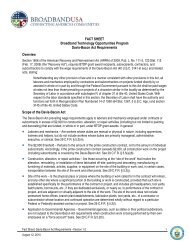

![Harry Potter [pdf]](https://img.yumpu.com/27329912/1/190x245/harry-potter-pdf.jpg?quality=85)
![Aplicaciones del Programa de Libros que Hablan [pdf] - Texas State ...](https://img.yumpu.com/27329907/1/190x245/aplicaciones-del-programa-de-libros-que-hablan-pdf-texas-state-.jpg?quality=85)


